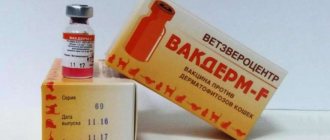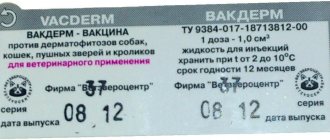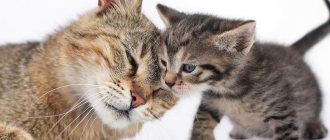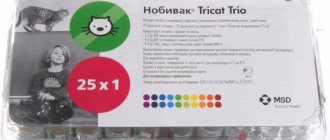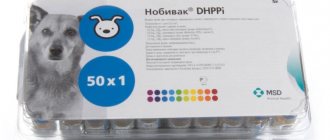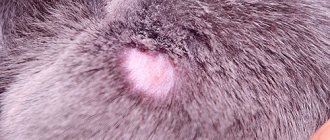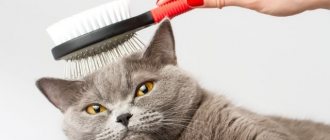Ringworm is a serious skin disease that affects both cats and dogs, as well as humans. It is caused by fungi of the genus Mycrosporum and Trichophyton, so in science the disease is called either microsporia or trichophytosis. From the point of view of the cat owner, there is no difference between them: the difference in symptoms is important for specialists, but the course of the disease in general and the treatment are very similar.
Find out more about how lichen is transmitted from a cat to a person>>>
Not only is lichen transmitted to humans, the treatment for this disease is quite long and requires significant efforts from owners to maintain hygiene in the home. And if one of the family members is sick, then until he recovers, you need to remain on sick leave.
Nobody wants such adventures, so the information that anti-lichen vaccines have been developed and are being used was greeted with enthusiasm all over the world. And then controversy began about the effectiveness of this rather expensive procedure.
So does it make sense to vaccinate cats against ringworm? Let's figure it out.
Ringworm in cats: is immunity possible?
Ringworm is a skin condition caused by a fungus. How possible is natural protection against such diseases in principle?
The immune system is a complex mechanism for protecting the body from diseases, usually viral ones.
Antiviral immunity works like this.
A virus is introduced into the body. The first to react to it are leukocytes, which recognize the genome of everything that is found in the body, according to the “friend or foe” principle. The virus is definitely foreign to them, and the body receives a command to create antibodies - special proteins that can make the stranger safe. When enough of these proteins have been produced, the disease stops. And if the same pathogen enters the body again, data on which antibodies are needed against it will be stored in special lymphocytes, which are called “memory cells.”
That is, there is no need to recognize what kind of stranger is in front of us, we just need to restart the biochemical factory to produce weapons against him. In addition, antibodies remaining after previous contact with the virus circulate in the blood and are ready to help immediately.
Knowing these principles, it is easy to understand why cats are regularly vaccinated against viral diseases - panleukopenia, rhinotracheitis, calicivirus and rabies. It is important that your pets have enough antibodies in their blood to resist the disease.
So, for immunity to appear according to this scheme, the pathogen must enter the blood. But ringworm is a fungus that lives in the hairs and surface layer of the skin. The contact of both the fungus and the mycelium with the skin is minimal, and it cannot end up in the blood.
In addition to general immunity, there are various types of local immunity. This includes skin immunity. The skin has its own leukocytes that can recognize antigens and produce antibodies to them. But this system has little connection with general immunity. However, the very fact of its existence led researchers to think that creating a vaccine against skin infections, for example, lichen, is possible.
Vaccinating a cat against lichen: pros and cons
There was initial excitement about shingles vaccines, but their use in small pets faded in Europe and the United States. Currently, there is not a single imported vaccine against dermatophytosis - microsporia and trichophytosis - on sale; these drugs have been withdrawn from the market and are no longer produced.
There are three reasons for this:
1) among domestic cats and dogs, the incidence of ringworm in the West is at an extremely low level;
2) post-marketing studies revealed extremely low, at the level of statistical error, effectiveness of preventive vaccination;
3) it was not possible to find out whether there is a therapeutic effect of the vaccine, since with a mild course, within the time specified in the instructions for the appearance of immunity (20-25 days after the second vaccination, which is separated from the first by another 14 days), dermatophytoses often resolve spontaneously.
Find out more about the signs of lichen in cats>>>
In Russia, vaccines against dermatophytosis are produced and used to this day.
However, leading dermatologists do not recommend this method of treatment to their patients, again finding no evidence of the effectiveness of such vaccination.
Proponents of vaccinations against dermatophytes point out that there are no studies proving the uselessness of these drugs. To this, the famous dermatologist Ekaterina Kuznetsova objects that such studies cannot happen for purely financial reasons; there are no those who benefit from paying for them. And we need to start from works that prove the need for such vaccines, but none of these drugs have been tested in a double-blind, placebo-controlled study. But there are many antifungal medications, both in ointments and tablets, that help quickly and effectively get rid of ringworm. Considering the relatively low prevalence of the disease among domestic cats and dogs, this is sufficient.
Find out more about the types of lichen in cats and how to treat it>>>
Some Western sources from 10-15 years ago contain evidence that vaccines against ringworm are effective for treating this disease as part of complex therapy (that is, together with antifungal tablets and/or ointments). Such data has already been excluded from modern publications.
Shelf life and storage conditions
Vakderm can be stored for a year from the production date (as we have already mentioned, it is indicated on each ampoule and bottle). Storage conditions: refrigerator (permissible temperature 2-10 °C).
For safety reasons, it is necessary to prevent children from having access to ampoules or vials.
It is prohibited to use:
- the drug has expired or has been stored in violation of the above conditions;
- ampoules or vials on which the necessary markings are missing or erased (we have already provided a list of information that must be applied by the manufacturer to the vaccine container);
- bottles (ampoules) that are damaged, not hermetically packaged, or opened more than half an hour ago;
- a drug whose appearance does not correspond to what was declared (has a different color or consistency, there is sediment or foreign impurities, mold, etc.).
If any of the above circumstances are present, the vaccine is discarded
This process does not require any additional disinfection measures, just ordinary precautions.
To vaccinate or not to vaccinate your cat against lichen is a question that every cat owner decides for himself. This vaccination is not mandatory by international standards, but it is included in the “vaccination calendar” of many veterinary clinics. "Vakderm" is one of the top three most common drugs used for these purposes, its price is quite affordable, and side effects are minimal.
A loving owner is concerned not only with the appearance of the pet, but also with its health. Unfortunately, cats are often susceptible to skin diseases such as dermatitis. Its peculiarity is that this disease can become dangerous for the cat owner. Preventing a disease is easier than treating it. Any experienced veterinarian will confirm this. In this article you will find instructions on how to combat lichen with the help of medications.
Therefore, it is worth taking care of your furry pet in advance by carrying out preventive vaccination
using the drug Vakderm-F. He will protect the cat:
When visiting a veterinary clinic, the cat owner will be offered vaccinations.
using Vakderm or Vakderm-F. Let's look at their distinctive features and determine which drug is right for your cat.
Common shingles vaccines for cats
Currently, only domestically produced vaccines against ringworm are available to veterinary specialists. Most of them are used in agriculture - both for cows and sheep, and for fur-bearing animals. For cats the following apply:
Vaccerm Vaccine for cats
It is made from cells of fungal cultures that cause dermatophytoses, although there is a misconception that the vaccine supposedly contains inactivated spores. Spores are a fairly large biological object, which, if introduced into a muscle, will definitely lead to inflammation even if it is non-viable, since the body will perceive it as a foreign body.
To obtain the vaccine, fungi are inactivated with formaldehyde; this substance is used to sterilize medical and veterinary instruments, as well as to preserve tissue obtained during operations for histological examination. The vaccine contains formalin at a concentration of 0.3%.
The vaccine can be used from the age of 1 month. According to the instructions, it is administered twice with an interval of 10-14 days; 20-25 days pass until stable immunity occurs. Thus, the effect of vaccination can be expected 30-40 days after the first injection.
The vaccine is available in powder form. Before injection, it should be diluted with saline solution. The prepared solution is stored for no more than 30 minutes. After this time, the remaining vaccine is disposed of. But, for example, if you need to vaccinate two kittens under 3 months of age, 1 bottle will be enough for both.
Preparation, contraindications, side effects are standard.
Vakderm-F
The same applies to this vaccine as to the previous one. Additionally, it contains the immunomodulator ribotan. The vaccine itself is liquid and does not require dilution. It can be used within 30 minutes after opening the bottle, so the bottle should be opened right in front of you.
Polivak-TM
It has the same properties and features as Vakderm, but formalin is not listed in the composition. Available in liquid form in 1 ml ampoules (1 dose), in various cases (depending on the age of the animal and the purpose of vaccination, treatment or prevention) the volume of administration of the drug varies from 0.5 to 2 ml (doses). The timing of administration and formation of immunity is the same as for Vakderm.
If "Vakderm" has a wide range of applications, it is designed for several types of animals, then "Polivak" is produced separately for cats, separately for dogs.
Microderm
The main properties are the same as those of the two previous vaccines. Available in dry and liquid form.
Vermette
Has the same properties as those listed above. Antigens were obtained by freeze drying.
Manufacturing form
Vakderm for lichen for cats is produced as a suspension for injections. The sterile solution has a pinkish color and uniform thickness without additional entries. The medicine is placed in insulated glass bottles of different capacities.
- One ampoule may contain: 1, 2, 10 ml of the drug.
- Each glass bottle is sealed with a rubber stopper held in place by an aluminum cap.
- Vials of the vaccine are packed in cardboard packages of 10 units.
Need to remember! The medicine Vakderm F for lichen is prescribed to be consumed half an hour after opening the bottle.
The shelf life of the medicine for dermatophytosis is 1 year. After completion of this period, the liquid should be removed from use. The vaccine becomes unusable in the sun and at a temperature of 15-25 degrees, so it must be placed in the refrigerator and kept at +2 to +10 degrees.
Preparing for vaccination
If you want your pet to be successfully vaccinated against infection, you need to properly prepare for vaccination. To do this, the following conditions must be met:
- Vaccination is carried out from the age of 2 months.
- Contraindications to the procedure are pregnancy, lactation.
- Be sure to follow the deadline and schedule established by the veterinarian.
- The animal must be healthy; after completion of active treatment of the last disease, at least 2 weeks must pass before vaccination, and if steroids were used (prednisolone, dexamethasone, hydrocortisone), then 3.
- If you plan to vaccinate for the first time, then it is worth protecting your pet from all sorts of stressful situations - moving to a new place, visiting guests, traveling on public transport, visiting exhibitions.
- If, before vaccination, the cat had contact with an animal infected or suspected of ringworm, vaccination should be postponed for 2 weeks.
- 10-14 days before vaccination, you need to treat the animal against parasites - worms and fleas.
- Before vaccination, be sure to carry out a minimum diagnosis for ringworm using a Wood's lamp.
Possible complications: The vaccination is usually well tolerated; a slight (!) decrease in activity in the animal is possible. The most common complication of vaccination is an abscess at the injection site.
Possible complications
The vaccine manufacturer warns that after administration of Vakderm-F, the cat may become drowsy or have a fever. This state lasts a maximum of three days. Some owners note that a swelling forms at the injection site after vaccination. To speed up the resorption of the seal, it is recommended to lubricate the problem area once with an alcohol solution of iodine.
If a cat begins to noticeably show signs of lichen after vaccination, it means that the animal has already been infected and the incubation period has passed. In such a situation, after two weeks it is also necessary to re-inject the vaccine, maintaining the dosage according to the instructions for use. There are no more serious complications after Vakderm F.

